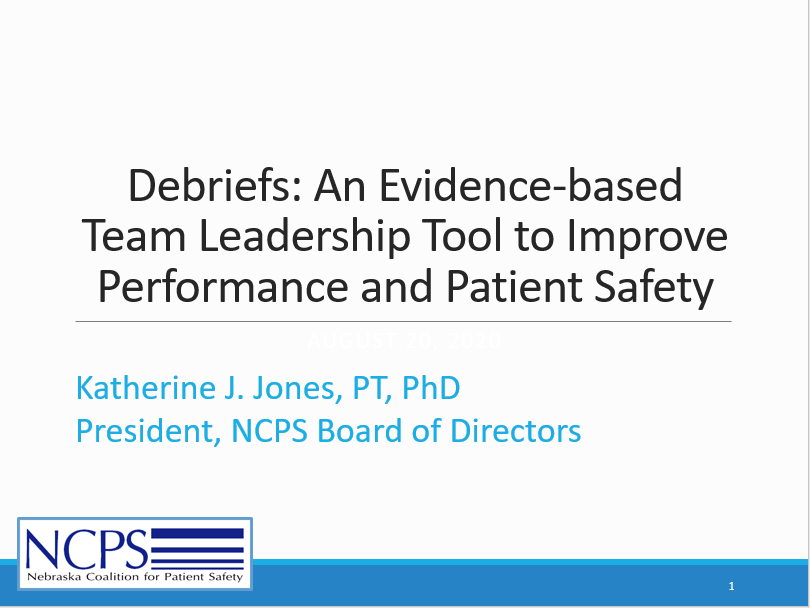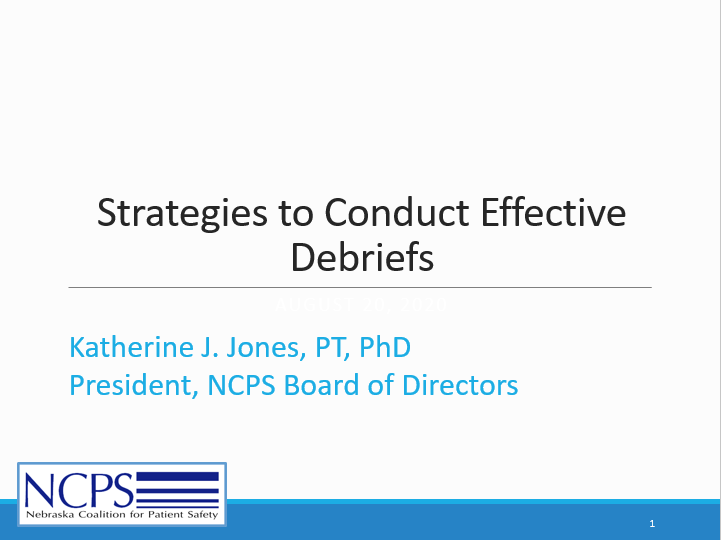Overview
This toolkit is intended to support Nebraska hospitals in their efforts to use debriefs to improve quality and patient safety in healthcare delivery. It was developed as part of a Debrief Implementation Collaborative program that NCPS coordinated in partnership with the following organizations:
- Bryan Health Rural Division
- CHI Health Nebraska, CAH Network
- Nebraska Perinatal Quality Improvement Collaborative
- Nebraska Association for Healthcare Quality Risk and Safety
- Nebraska Coalition for Patient Safety
- Nebraska Hospital Association
Funding for the Debrief Implementation Collaborative was provided by the Nebraska Department of Health and Human Services, Division of Public Health Office of Rural Health, Flex Program.
Debriefs
What is a debrief?
A debrief is a specific type of team meeting in which members discuss, make sense of, and learn from a recent event in which they collaborated*
- Briefs, huddles, and debriefs initiate the teamwork system.
- Effective debriefs are conducted by a trained facilitator who uses a structured guide to ensure psychological safety and team reflection.
- Structured debriefs may be generic or event specific and used by clinical and non-clinical teams to improve system outcomes.
*Scott C, Allen JA, Bonilla D, et al. Ambiguity and freedom of dissent in post incident discussion. Journal of Business Communication. 2013;50: 383– 402. http://dx.doi.org/10.1177/0021943613497054
Why should debriefs be used?
Teams use debriefs to make sense of and learn from an event. According to Battles et al*, sensemaking is "the active process of assigning meaning to ambiguous data." Sensemaking is a conversation among members of an organization about an unexpected, novel or ambiguous event that is conducted by a trained facilitator.
- Each team member brings their unique knowledge and experience of the event to the conversation.
- A facilitator uses a structured process to help team members combine these unique perspectives into a new shared mental model of what happened.
- Team members use this shared mental model to develop an action plan that decreases risks/hazards to individual patients and the system.
- Evidence indicates that effective debriefs decrease the risk of repeat events for individual patients, improve system outcomes, and improve staff perceptions of safety culture.
* Battles JB, Dixson NM, Borotkanics RJ et al. Sensemaking of Patient Safety Risks and Hazards. HSR. 2006; 41 (Part II):1555-1575.
Click on the titles below to download the valuable resources in this toolkit!
Debrief Implementation Collaborative Webinars
Debrief Implementation Support Calls
Generic Debrief Guides
-
Source: Nebraska Coalition for Patient Safety
Structures to Plan and Standardize the Debrief Program
-
Source: Nebraska Coalition for Patient Safety
-
Source: Nebraska Coalition for Patient Safety
-
Source: Nebraska Coalition for Patient Safety
-
Source: Nebraska Coalition for Patient Safety
-
Source: Nebraska Coalition for Patient Safety
Event Specific Debrief Guides
-
AHRQ Debriefing for Clinical LearningSource: Agency for Healthcare Research and Quality (AHRQ)
-
Source: Association of PeriOperative Registered Nurses.
Available at https://www.aorn.org/guidelines/clinical-resources/tool-kits/correct-site-surgery-tool-kit/aorn-comprehensive-surgical-checklist -
Source: Nebraska Peri-Natal Quality Improvement Collaborative
-
Source: Nebraska Peri-Natal Quality Improvement Collaborative
-
Source: Jones KJ, Crowe J, Allen J, et al. The impact of post-fall huddles on repeat fall rates and perceptions of safety culture: a quasi-experimental evaluation of a patient safety demonstration project. BMC Health Services Research.2019;19(650):1-14.
Council On Patient Safety In Women’s Health Care Patient Safety Bundles
This collection of evidenced-based care bundles has been developed by and is available from the Council on Patient Safety in Women’s Health Care.









